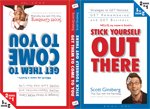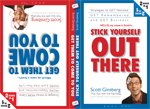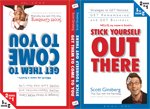 When I was a kid, my dad used to bring me to the trade shows to help set up his booth.
When I was a kid, my dad used to bring me to the trade shows to help set up his booth.
The only problem was, we’d have to get there early.
Like, really early. On a Saturday. When nobody else was there yet. When I should have been in the hotel room watching Voltron.
One day I asked him, “Dad, why do we have to get here so early? And why are you here, opening boxes, getting all dirty and sweaty – you’re the president of the company!”
I’ll never forget what he said to me next:
“Scott, look around at the all the other booths: These are my competitors. And if you watch closely on the day before the trade show, you won’t see any other company presidents setting up the booths.”
“Wow Dad! You mean you arrive here early just to show your employees that you’re not too good to get dirty?”
“Well, that’s part of it. But the real message isn’t to MY employees – it’s to my THEIR employees. Because I want them to look up from their dirty, sweaty boxes, and see ME, the president of the competition, across the aisle, at seven in the morning, on a Saturday – making their president look like a putz. That’s why our company is called Closeouts with Class, Scott: Not just classy products – classy people.”
And that’s how you make people hate you.
Now, allow me to explain.
First of all, people don’t hate my dad.
Secondly, I’m not suggesting you want people to (actually) hate you like they hate, say, Paris Hilton or that guy from the Micro Machines commercial.
MY THEORY IS: Being hated is an indicator of success.
And when I say, “being hated,” I don’t mean that people literally want to cause you bodily harm.
It’s more like resentment. Jealousy. Animosity. All of which stem from envy.
Ultimately, being hated isn’t something you do intentionally TO make a name for yourself; it’s something that happens incidentally AS you make a name for yourself.
Here’s how to make that happen:
1. Ask hater questions. If your competitors don’t (currently) hate you, what could you execute in the next week that would get them to want to strangle you with an orange extension cord? Ask this question to yourself and to your team every Monday morning, you’ll have more haters than you’ll know what to do with.
Then again, you’ll also have more customers than you know what to do with. It’s like my mentor Jeffrey Gitomer says, “When my competitors come to my website, I want them to hate my friggin guts because they know their website is a piece of junk!” Does your competition hate you?
2. Be exceptionally educated. My other mentor, Bill Jenkins, once wrote a sermon called, “The Cost of God’s Gifts.” Oxymoronic as it sounded, his theory was right: Knowledge creates its own enemies.
Not that you should memorize the encyclopedia, get a bunch of degrees and introduce yourself with four acronyms after your last name. Education comes from experience, intelligent reflection upon that experience and disciplining yourself to catalogue what you learned from that experience.
If you do that every day of your life, you’ll become a fountain of wisdom and insight. That people will want to pee in. What did you write yesterday?
3. Be the exception. Nothing pisses people off more than when you refuse to imprison yourself by adopting the illusions they blindly accepted as rules. If only they had your obstinate sense of self-protection. If only.
Sadly, most people are other people. They allow the world to dictate what they want and what’s important to them. You, on the other hand, are the exception to every rule. Or, you change the rules so you can win at your own game. Or, you change the game completely so there are no rules.
Either way, people hate you for that. Well done. What rules don’t you subscribe to?
4. Do what you love. In a recent daily cartoon, Hugh McLeod wrote, “Getting a lot of people to hate you is easy: All you have to do is become really successful at doing something you love.”
Lesson learned: Do what you love and the hatred will follow – from jealous people who aren’t doing what they love, that is.
And if you have a hard time being viewed that way, just remember that you’re nobody until somebody hates you anyway. May as well start now. How many hours of your typical workday are spent doing things you love?
5. Just be different. In Lyn Lofland’s A World of Strangers, she reveals: “We don’t like strangers because their differences threaten to contaminate our sense of self.”
Ever felt that way? That someone resented you just because you were different from them? Good. Every time that happens, pat yourself on the back. You’re on your way. What is your Personal Differential Advantage?
6. Make things happen. There’s nothing more annoying than someone who executes exquisitely and consistently. Especially to the population of the world that spends all their time talking their ideas into the ground.
Your mission is to keep asking, “What’s the next action?” To (not) be stopped by not knowing how. And to keep your entrepreneurial eyes peeled for barriers to execution like hesitation, ambiguity and inertia. What could you make happen by lunch today?
7. Manage to get out. Of a toxic relationship. Of a crappy job. Of a sticky situation. Of a go-nowhere town. Of a downward spiral. Doesn’t matter.
Anytime you rise like a Phoenix from out of the flames – and do so with determination, poise and passion – the people who don’t have the stones to cut their own dirty ropes will resent you to no end.
Because while you managed to get out, they chose to remain stuck. Are you quitting when it’s hard or when it’s right?
8. Promote radical ideas. See if you can identify what the following people have in common: Jesus, Martin Luther King, John F. Kennedy, Joan of Arc, Abraham Lincoln and John Lennon.
Give up? Try this: They were all, at some point in time, hated or resented for their radical ideas.
Sadly, the other commonality is that they were all, at some point in time, murdered for their radical ideas.
No wonder people are scared to voice their opinion – they might be killed! I guess our society isn’t ready for radical thinking yet. Maybe we’ll give it another two thousand years.
Anyway, I’m not suggesting you change you become a martyr. And I doubt you will be nailed to a cross or burned at the stake for voicing your opinion. I just thought you’d like to know history has proved. What are you willing to suffer for?
9. Pursue your dream persistently and authentically. Let’s turn to the book Do It! Let’s Get Off Our Butts, by Peter McWilliams. He wrote:
“People don’t like to see others pursuing their dreams – it reminds them how far from living their own dreams they are. In talking you out of your dreams, they are taking themselves back into their comfort zone.”
Lesson learned: Let your unflinching pursuit of your dreams be a mirror of other people’s mediocrity. Sure, people might resent you. But know that your persistent and authentic quest will serve as a motivators for people’s own journeys. Is it worth being hated if it jolts people out of their drudgery?
10. Self-confidence threatens weak people. I’ve been wearing a nametag 24-7 for the past ten years. And while it sounds so simple, cool and playful, doing so (actually) requires a tremendous amount of confidence in my personhood, comfort in my own skin and commitment to sticking myself out there.
Is it any surprise that complete strangers walk right up to me in the middle of public places, rip my nametag off and tear into a dozen pieces? Yikes. I guess some people’s sense of self is threatened by a sticker. What response will your self-confidence elicit from others?
11. Smile all the time. It’s weird: Some people don’t think other people deserve to be happy. It’s simply not fair how crappy their lives are, and their misery is itching for company.
That’s why smiling all the time drives people crazy. Especially those terminally negative chumps who convince themselves that it’s easier to be miserable all the time.
Your smile reminds them of how sad their lives really are. Almost like a reverse entitlement attitude and victim mentality combined. My suggestion is: Don’t let this mixture infiltrate your life. It’s more poisonous than cyanide.
Instead, let your happiness – as expressed through your constant smile – contagiously infect those around you. How many people went out of their way to avoid you yesterday?
12. Take truth serum. Want a surefire way to boil people’s blood? Practice radical truth telling, challenge injustice and dispel pleasant myths. This type of honesty makes people nervous. Especially when they’re so used to living in a world of lies.
The reality is: When you walk your truth in a world of mostly (fiction), people notice. They might hate you, but they still notice. And because awareness is always the first step toward mastery, attention is a great first step. How are you branding your honesty?
13. Walk your truth. To quote my favorite book, The War of Art, “We see others beginning to live their authentic selves, it drives us crazy if we have not lived our own.”
Lesson learned: When you walk your truth on a daily basis, it serves as an alarm clock for the inauthentic. And understand that when people see those who hold themselves to a standard they don’t, resentment grows. Do not shrink from this. What are you trading your authenticity for?
One final thought.
In 2005, The Beast published an article called, “50 Most Hated People in America.”
On the list, you can find people like Martha Stewart, George Lucas, Tom Cruise, Donovan McNabb, Johnny Damon, Hilary Clinton, Joe Lieberman, Oprah Winfrey, Thomas Friedman and Michael Jackson.
Now, I’m not here to defend or argue the validity of any of these selections. Nobody on this list is perfect. Especially Oprah.
I just think it’s interesting to note the commonalities:
All of these people are wealthy, successful and well known.
All of these people have pursued – and are pursuing – their dreams.
All of these people are making – or have made – a name for themselves.
Maybe you need to spend less time being liked and more time getting people to hate you.
Because if you’re not pissing off (at least) some people, you’re doing something wrong.
LET ME ASK YA THIS…
Who hates you?
LET ME SUGGEST THIS…
For the ebook called, “101 Lessons Learned from Wearing a Nametag 24-7,” send an email to me, and you win the list for free!
Scott Ginsberg
That Guy with the Nametag
Author, Speaker, Entrepreneur, Mentor
[email protected]
 Never the same speech twice.
Never the same speech twice.
Always about approachability.
Watch The Nametag Guy in action here!
 1. Applicability is the bridge between information and insight. Anyone can be a vending machine of good information. Only a true thought leader could bridge the gap. The difference is: Information is just content; insight is a penetrating mental vision. Which one do you deliver?
1. Applicability is the bridge between information and insight. Anyone can be a vending machine of good information. Only a true thought leader could bridge the gap. The difference is: Information is just content; insight is a penetrating mental vision. Which one do you deliver? The world’s FIRST two-in-one, flip-flop book!
The world’s FIRST two-in-one, flip-flop book!
 Abrasives. Automotive accessories. Bearings. Building supplies. Cattle. Chemicals. Coffee beans. Computer Hardware. Converters. Envelopes. Fertilizer. Grain. Industrial metals. Insurance. Laboratory equipment. Minerals. Oil. Office supplies. Precious metals. Salt. Soybeans. Sugar. Textiles. Wheat. Wool.
Abrasives. Automotive accessories. Bearings. Building supplies. Cattle. Chemicals. Coffee beans. Computer Hardware. Converters. Envelopes. Fertilizer. Grain. Industrial metals. Insurance. Laboratory equipment. Minerals. Oil. Office supplies. Precious metals. Salt. Soybeans. Sugar. Textiles. Wheat. Wool. 
 “Wow, that takes balls.”
“Wow, that takes balls.” The world’s FIRST two-in-one, flip-flop book!
The world’s FIRST two-in-one, flip-flop book! There’s a fine line between boundary management and self-righteous entitlement.
There’s a fine line between boundary management and self-righteous entitlement. 1. “Don’t put all your eggs in one basket.”
1. “Don’t put all your eggs in one basket.” Being an entrepreneur is risky.
Being an entrepreneur is risky. The world’s FIRST two-in-one, flip-flop book!
The world’s FIRST two-in-one, flip-flop book! Do you want to dramatically shrink your creative output?
Do you want to dramatically shrink your creative output? The world’s FIRST two-in-one, flip-flop book!
The world’s FIRST two-in-one, flip-flop book! When I was a kid,
When I was a kid,  1. Give yourself permission to ask for what you need. Expectational clarity is a beautiful thing: It saves time, prevents extra work and lowers the probability of future surprises.
1. Give yourself permission to ask for what you need. Expectational clarity is a beautiful thing: It saves time, prevents extra work and lowers the probability of future surprises. The world’s FIRST two-in-one, flip-flop book!
The world’s FIRST two-in-one, flip-flop book! Being amazing isn’t enough.
Being amazing isn’t enough.